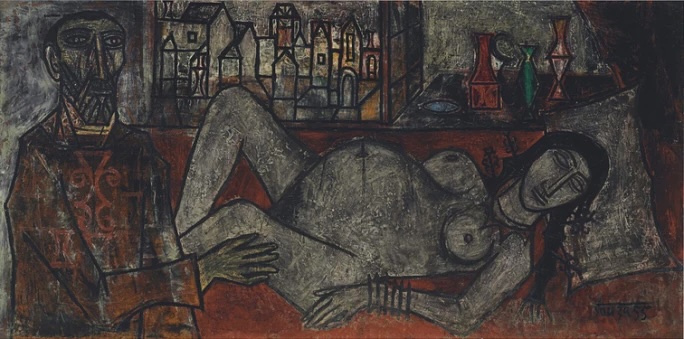In 1947, as India emerged as a new democracy, the art world witnessed the birth of a transformative movement. The Progressive Artists’ Group (PAG) arose from the vibrant city of Bombay (now Mumbai), founded by visionary artists F.N. Souza, M.F. Husain, S.H. Raza, K.H. Ara, H.A. Gade, and S.K. Bakre. Formed just months after the August 14, 11947, Partition of India and Pakistan—a traumatic event marked by widespread religious rioting and the displacement of tens of thousands—PAG’s founders drew profound inspiration from this conflict. They sought to redefine the visual arts in India, using the partition’s impact as a catalyst for their revolutionary vision. By embracing modernist principles, they boldly ushered Indian art into a new era, setting new standards with their innovative and transformative approach.


PAG marked a significant departure from the romantic nationalism of the Bengal School. Instead of adhering to a single, unified style, PAG embraced a fusion of influences, blending India’s rich artistic heritage with modernist movements from Europe and North America. Drawing from Post-Impressionism, Cubism, and Expressionism, PAG artists introduced a bold new aesthetic that challenged established norms and laid the groundwork for contemporary Indian art.
Each PAG member contributed their distinctive voice, pushing artistic boundaries. F.N. Souza’s work, known for its raw intensity and unflinching portrayals of the human condition, often provoked strong reactions. His painting Birth, which achieved over $4 million at auction in 2015, underscores the enduring global resonance of his work.
M.F. Husain celebrated as the “Picasso of India,” captivated audiences with vibrant compositions that intertwined Indian mythology with contemporary themes. S.H. Raza’s abstract landscapes, rich in spiritual symbolism and powerful colour use, offered a meditative quality. K.H. Ara’s realistic urban portrayals and H.A. Gade’s modernist landscapes further enriched Indian art, while S.K. Bakre’s sculptures introduced new dimensions.
The formation of PAG was both an artistic and cultural revolution. Their first exhibition in 1948 was a landmark event, showcasing their modernist vision and capturing significant attention. The group’s work resonated with a rapidly changing India, marked by socio-political upheavals and a quest for a new identity. Their emphasis on personal expression, experimentation, and freedom became a guiding light for future generations of artists.
Internationally, PAG played a crucial role in placing Indian art on the global map. Their participation in international exhibitions, including notable shows in Europe and the United States, garnered acclaim and recognition, influencing the broader art community and fostering a spirit of innovation in India.
Although PAG disbanded by 1950, with key members like Souza and Raza leaving, its spirit continued through artists such as Vasudeo S. Gaitonde, Krishen Khanna, and Mohan Samant, alongside original members M.F. Husain, H.A. Gade, and K.H. Ara. The group held three significant exhibitions: in 1948 at the Bombay Art Society’s Salon, in 1950 in Kolkata, and their final show in 1953.
The Progressive Artists’ Group remains a cornerstone of modern Indian art history. Their pioneering efforts paved the way for subsequent movements and artists, establishing a vibrant, diverse, and dynamic art scene that continues to reflect the complexities and richness of Indian culture today.






Acrylic on canvas
52″ x 70″











